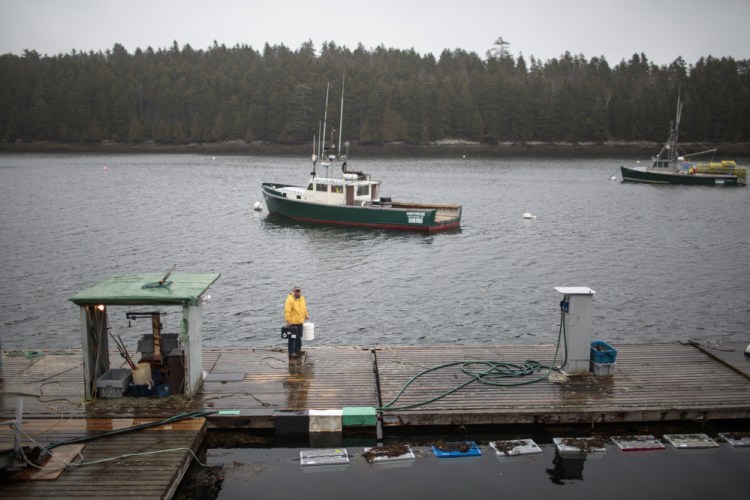Topsham resident Don Gower was recently recognized by the Friends of Casco Bay for his five years of service as a water quality volunteer, gathering the data the environmental organization uses to track the bay’s health. We got talking to the retiree about his 40 years at Burnham and Morrill, aka B&M Beans, how many times he’s climbed Katahdin and how someone who was always more of a lake guy came to be sitting on the dock of the bay every April, plunging his hands into very cold water.
BACKSTORY: Gower retired at 61 and felt a desire to give back to the community. “I was looking for something, to do a few good things,” he said. “I couldn’t do much when I was at work because I was pretty devoted to work.” He’d grown up in Bath, coming of age in the Maine of fouled rivers and mill stench. In the course of his four decades working at B&M he made that drive south to Portland daily. “You had to hold your breath as you went across the Presumpscot,” he remembered. “The smells from the mills.” Then he watched as the water improved. “I always felt that our generation of baby boomers at least have done one thing right.”
FRIENDS OF FRIENDS: But as he said, the problems for Casco Bay are not so visible – or pungent – today, but they’re present, from the warming temperatures changing the ecosystem and affecting the sea life to chemical runoffs from lawn-care products and acid rain changing the chemistry and pH of the seawater. When he started volunteering, he didn’t know much about Friends of Casco Bay, other than that his son-in-law worked there and that they were the stewards of the bay. If there was something “funky going on,” he thought the group was taking care of it. “Now of course I realize that it is a daily effort.” And that data is key to that effort. “You can solve any problem in the world if you have the right and reliable data,” he said. “The other thing I like is their approach to problem-solving. They are like, ‘Let’s work together.’ They are not about taking you to court to sue you … They are a very pragmatic group.”
THE RIGHT SPOT: His test spot, Pinkham Point on Great Island in Harpswell, was assigned to him. Friends of Casco Bay has about 40 sites it tests regularly from April to October and when Gower signed up, the organization needed someone in the Brunswick area. The Waddle family, which runs a small vacation rental spot adjacent to its dock, offered Friends of Casco Bay easy water access. And as assignments go, this was a good one. (Way better than unloading beans from a railroad car.) “It is gorgeous, and it is very easy to sample water there. I just go and do my thing, and the people there have been very supportive of that.”
HIS THING: Testing involves gathering two samples on the appointed day (the group picks 10 dates over the six-month period), the first at 7 a.m. and the second at 3 p.m. Volunteers are trained to collect baseline data on salinity, dissolved oxygen, temperature, pH, water clarity and nutrients. (And Friends of Casco Bay is always looking for more volunteers.) They don’t test in the winter, because water issues tend to be more exacerbated during the warmer months, but around the time the air begins to warm, Gower is out there. “The first one in April is hard on the hands.”
BAY BABY-SITTING? What if he’s got a trip planned on one of the days he is supposed to sample? Data doesn’t take a raincheck, so Friends of Casco Bay will send a substitute when Gower heads for his annual trip to Baxter State Park (he’s been doing that for almost 50 years, including about a dozen times to the summit of Katahdin). So is he a nature guy? “I wouldn’t call myself extreme, but I do like to get outside.” His father was from central Maine, near Dexter, and when Gower was young, they explored lakes together. Never much on the ocean though, and in fact, this protector of Casco Bay has spent very little time on the bay itself. “I have taken the Casco Bay ferry from down at Cook’s Lobster House like three times, but that is about it.”
A JOB WITH A VIEW: That’s not to say he hasn’t spent plenty of time looking at the bay, both from Pinkham Point and back in the B&M days. “I spent 40 years, right there,” he said. “You could touch it from our plant.” His first job at B&M was sifting flour for the brown bread, a good amount of which ended up powdering his hair. “I would come home looking very old,” he said. And he stayed there until he had genuine gray hair.
BEANS FOR LIFE: What made him stay so long? He didn’t have much direction, as a young man, he said, but he had a wife and two children to support and B&M felt like a family to him, even when there were about 400 employees. “You knew everybody and everybody knew you,” he remembered. Another one of his early jobs was unloading 100-pound sacks of dried beans from the railroad cars that used to pull right up to the plant. Twenty years ago, some of those were yellow-eyed beans from Maine, soldier beans to be canned, although eventually, the locally grown beans became too expensive compared to those from say, Michigan. Gower moved up through the ranks, all the way to the plant manager, the job he held when he retired. “It was nice working for a company that made food for people.”
Send questions/comments to the editors.




